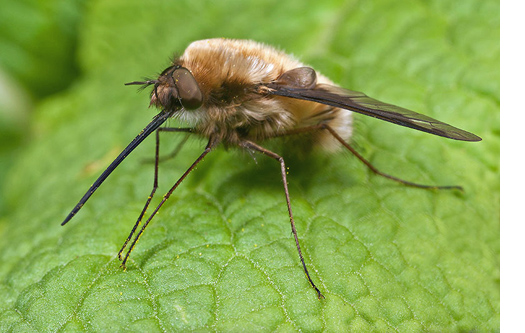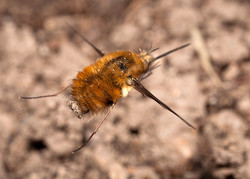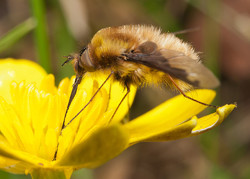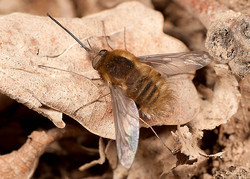Bees, Flies & Bee-flies - The Bee-fly, Bombylius major
09th April 2012
In: April 2012
 If it wasn’t difficult enough differentiating Britain’s many varieties of bees and wasps, there are many species of fly that are bee and wasp mimics. One Spring-flying example is the Dark-edged Bee-fly or Large Bee-fly (Bombylius major). This is the most common of a small number of British Bee-flies.
If it wasn’t difficult enough differentiating Britain’s many varieties of bees and wasps, there are many species of fly that are bee and wasp mimics. One Spring-flying example is the Dark-edged Bee-fly or Large Bee-fly (Bombylius major). This is the most common of a small number of British Bee-flies.Like a small bumble bee, they are covered in hair. They also have a long proboscis for drinking nectar from deep flowers. They are very active and are expert fliers, often seen hovering. At rest, you will see the characteristic dark markings along the leading edges of the wings.
Not only do they look like bees; bee-flies are parasitoids (parasites that eventually kill their host) of several bee species, particularly mining bees such as Andrena. Female bee-flies will hover and flick their eggs in or near to the tunnels of solitary bees (or in a habitat that is suitable for the host bee). Once in the tunnel, the egg hatches and the worm-like larva crawls into an open host cell. It remains inactive until the host larva is about to pupate. It then attaches itself to the outside of the bee larva, sucking out its body fluids and killing it.



The image (above left) shows a female Bombylius major hovering, the central image shows a male resting on a leaf in the centre of an Andrena clarkella Mining bee colony. The right hand image shows one using its long proboscis to feed on a flower.
Bombylius major is found throughout the UK, more commonly in the South and flies from April to June. Often seen around primroses.
Larger images can be seen in the Image Gallery.